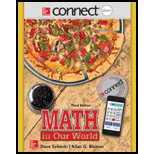Problem 1TTO: Add in base five: 324five + 203five. Problem 2TTO Problem 3TTO Problem 4TTO Problem 5TTO Problem 6TTO Problem 7TTO Problem 1E: While hanging around one evening, your roommate is paging through your math book, and sees the... Problem 2E Problem 3E Problem 4E Problem 5E Problem 6E: Make an addition table for base four. Problem 7E Problem 8E Problem 9E: For Exercises 940, perform the indicated operations. 9. 33four+22four Problem 10E: For Exercises 940, perform the indicated operations. 10. 44five+33five Problem 11E Problem 12E: For Exercises 940, perform the indicated operations. 12. 8A2Btwelve+191Atwelve Problem 13E: For Exercises 940, perform the indicated operations. 13. 321six+1255six Problem 14E: For Exercises 940, perform the indicated operations. 14. 143five+432five Problem 15E: For Exercises 940, perform the indicated operations. 15. 78874nine+33137nine Problem 16E: For Exercises 940, perform the indicated operations. 16. 64605seven+23456seven Problem 17E: For Exercises 940, perform the indicated operations. 17. 1432five413five Problem 18E: For Exercises 940, perform the indicated operations. 18. 143five34five Problem 19E: For Exercises 940, perform the indicated operations. 19. 212seven136seven Problem 20E: For Exercises 940, perform the indicated operations. 20. 9327eleven7318eleven Problem 21E: For Exercises 940, perform the indicated operations. 21. 42831nine2781nine Problem 22E: For Exercises 940, perform the indicated operations. 22. 6323seven415seven Problem 23E: For Exercises 940, perform the indicated operations. 23. 12ABtwelve93Atwelve Problem 24E: For Exercises 940, perform the indicated operations. 24. 7A4Cfourteen2CCDfourteen Problem 25E: For Exercises 940, perform the indicated operations. 25. 525six4six Problem 26E: For Exercises 940, perform the indicated operations. 26. 241seven6seven Problem 27E: For Exercises 940, perform the indicated operations. 27. 818nine62nine Problem 28E: For Exercises 940, perform the indicated operations. 28. 423five332five Problem 29E: For Exercises 940, perform the indicated operations. 29. AB5twelve42twelve Problem 30E: For Exercises 940, perform the indicated operations. 30. 5186nine23nine Problem 31E: For Exercises 940, perform the indicated operations. 31. 5432six153six Problem 32E: For Exercises 940, perform the indicated operations. 32. C429thirteenB24thirteen Problem 33E: For Exercises 940, perform the indicated operations. 33. 3nine1568nine Problem 34E: For Exercises 940, perform the indicated operations. 34. 2three1202three Problem 35E: For Exercises 940, perform the indicated operations. 35. 4five2023five Problem 36E: For Exercises 940, perform the indicated operations. 36. 6seven1425seven Problem 37E: For Exercises 940, perform the indicated operations. 37. 2434five 14five Problem 38E: For Exercises 940, perform the indicated operations. 38. 3222four 21four Problem 39E: For Exercises 940, perform the indicated operations. 39. ABC2fourteen 5Cfourteen Problem 40E: For Exercises 940, perform the indicated operations. 40. 92A0twelve 2Btwelve Problem 41E: The binary, octal, and hexidecimal systems are used extensively in computer programming; arithmetic... Problem 42E: The binary, octal, and hexidecimal systems are used extensively in computer programming; arithmetic... Problem 43E: The binary, octal, and hexidecimal systems are used extensively in computer programming; arithmetic... Problem 44E Problem 45E: The binary, octal, and hexidecimal systems are used extensively in computer programming; arithmetic... Problem 46E: The binary, octal, and hexidecimal systems are used extensively in computer programming; arithmetic... Problem 47E: The binary, octal, and hexidecimal systems are used extensively in computer programming; arithmetic... Problem 48E: The binary, octal, and hexidecimal systems are used extensively in computer programming; arithmetic... Problem 49E: The binary, octal, and hexidecimal systems are used extensively in computer programming; arithmetic... Problem 50E: The binary, octal, and hexidecimal systems are used extensively in computer programming; arithmetic... Problem 51E: The binary, octal, and hexidecimal systems are used extensively in computer programming; arithmetic... Problem 52E: The binary, octal, and hexidecimal systems are used extensively in computer programming; arithmetic... Problem 53E: The binary, octal, and hexidecimal systems are used extensively in computer programming; arithmetic... Problem 54E: The binary, octal, and hexidecimal systems are used extensively in computer programming; arithmetic... Problem 55E Problem 56E Problem 57E Problem 58E Problem 59E Problem 60E Problem 61E Problem 62E Problem 63E Problem 64E Problem 65E Problem 66E Problem 67E: The American Standard Code for Information (ASCII) is used to encode characters of the alphabet as... Problem 68E Problem 69E Problem 70E Problem 71E Problem 72E Problem 73E Problem 74E Problem 75E Problem 76E format_list_bulleted


 Algebra: Structure And Method, Book 1AlgebraISBN:9780395977224Author:Richard G. Brown, Mary P. Dolciani, Robert H. Sorgenfrey, William L. ColePublisher:McDougal Littell
Algebra: Structure And Method, Book 1AlgebraISBN:9780395977224Author:Richard G. Brown, Mary P. Dolciani, Robert H. Sorgenfrey, William L. ColePublisher:McDougal Littell Elementary AlgebraAlgebraISBN:9780998625713Author:Lynn Marecek, MaryAnne Anthony-SmithPublisher:OpenStax - Rice University
Elementary AlgebraAlgebraISBN:9780998625713Author:Lynn Marecek, MaryAnne Anthony-SmithPublisher:OpenStax - Rice University Holt Mcdougal Larson Pre-algebra: Student Edition...AlgebraISBN:9780547587776Author:HOLT MCDOUGALPublisher:HOLT MCDOUGAL
Holt Mcdougal Larson Pre-algebra: Student Edition...AlgebraISBN:9780547587776Author:HOLT MCDOUGALPublisher:HOLT MCDOUGAL

